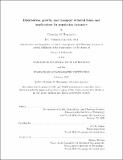| dc.contributor.advisor | Joel Llopiz. | en_US |
| dc.contributor.author | Hernández, Christina M.,Ph. D.(Christina Maria)Massachusetts Institute of Technology. | en_US |
| dc.contributor.other | Joint Program in Biological Oceanography. | en_US |
| dc.contributor.other | Massachusetts Institute of Technology. Department of Earth, Atmospheric, and Planetary Sciences. | en_US |
| dc.contributor.other | Woods Hole Oceanographic Institution. | en_US |
| dc.date.accessioned | 2021-06-04T17:00:34Z | |
| dc.date.available | 2021-06-04T17:00:34Z | |
| dc.date.copyright | 2021 | en_US |
| dc.date.issued | 2021 | en_US |
| dc.identifier.uri | https://hdl.handle.net/1721.1/130901 | |
| dc.description | Thesis: Ph. D., Joint Program in Biological Oceanography (Massachusetts Institute of Technology, Department of Biology; and the Woods Hole Oceanographic Institution), February, 2021 | en_US |
| dc.description | Cataloged from the official PDF of thesis. | en_US |
| dc.description | Includes bibliographical references (pages 119-135). | en_US |
| dc.description.abstract | The early life stages of marine fishes play a critical role in population dynamics, largely due to their high abundance, high mortality, and ease of transport in ocean currents. This dissertation demonstrates the value of combining larval data, collected in the field and the laboratory, with model simulations. In Chapter 2, analyses of field observations of ontogenetic vertical distributions of coral reef fish revealed a diversity of behaviors both between and within families. In Caribbean-wide particle-tracking simulations of representative behaviors, surface-dwelling larvae were generally transported longer distances with greater population connectivity amongst habitat patches, while the evenly-distributed vertical behavior and downward ontogenetic vertical migration were similar to one another and led to greater retention near natal sites. However, hydrodynamics and habitat availability created some local patterns that contradicted the overall expectation. | en_US |
| dc.description.abstract | Chapter 3 presents evidence of tuna spawning inside a large no-take marine protected area, the Phoenix Islands Protected Area (PIPA). Despite variation in temperature and chlorophyll, the larval tuna distributions were similar amongst years, with skipjack (Katsuwonus pelamis) and Thunnus spp. tunas observed in all three years. Backtracking simulations indicated that spawning occurred inside PIPA in all 3 study years, demonstrating that PIPA is protecting viable tuna spawning habitat. In Chapter 4, several lines of larval evidence support the classification of the Slope Sea as a major spawning ground for Atlantic bluefin tuna with conditions suitable for larval growth. The abundance of bluefin tuna larvae observed in the Slope Sea aligns with typical observations on the other two spawning grounds. | en_US |
| dc.description.abstract | Age and growth analyses of bluefin tuna larvae collected in the Slope Sea and the Gulf of Mexico in 2016 did not show a growth rate difference between regions, but did suggest that Slope Sea larvae are larger at the onset of exogenous feeding. Collected larvae were backtracked to locations north of Cape Hatteras and forward tracked to show that they would have been retained within the Slope Sea until the onset of swimming. As a whole, this thesis presents valuable contributions to the study of larval fishes and the attendant implications for marine resource management. | en_US |
| dc.description.statementofresponsibility | by Christina M. Hernández. | en_US |
| dc.format.extent | 135 pages | en_US |
| dc.language.iso | eng | en_US |
| dc.publisher | Massachusetts Institute of Technology | en_US |
| dc.rights | MIT theses may be protected by copyright. Please reuse MIT thesis content according to the MIT Libraries Permissions Policy, which is available through the URL provided. | en_US |
| dc.rights.uri | http://dspace.mit.edu/handle/1721.1/7582 | en_US |
| dc.subject | Joint Program in Biological Oceanography. | en_US |
| dc.subject | Earth, Atmospheric, and Planetary Sciences. | en_US |
| dc.subject | Woods Hole Oceanographic Institution. | en_US |
| dc.title | Distribution, growth, and transport of larval fishes and implications for population dynamics | en_US |
| dc.type | Thesis | en_US |
| dc.description.degree | Ph. D. | en_US |
| dc.contributor.department | Joint Program in Biological Oceanography. | en_US |
| dc.contributor.department | Massachusetts Institute of Technology. Department of Earth, Atmospheric, and Planetary Sciences | en_US |
| dc.contributor.department | Woods Hole Oceanographic Institution | en_US |
| dc.contributor.department | Massachusetts Institute of Technology. Department of Biology | |
| dc.contributor.department | Massachusetts Institute of Technology. Department of Ocean Engineering | |
| dc.identifier.oclc | 1251897010 | en_US |
| dc.description.collection | Ph.D. Joint Program in Biological Oceanography (Massachusetts Institute of Technology, Department of Biology; and the Woods Hole Oceanographic Institution) | en_US |
| dspace.imported | 2021-06-04T17:00:34Z | en_US |
| mit.thesis.degree | Doctoral | en_US |
| mit.thesis.department | Bio | en_US |
